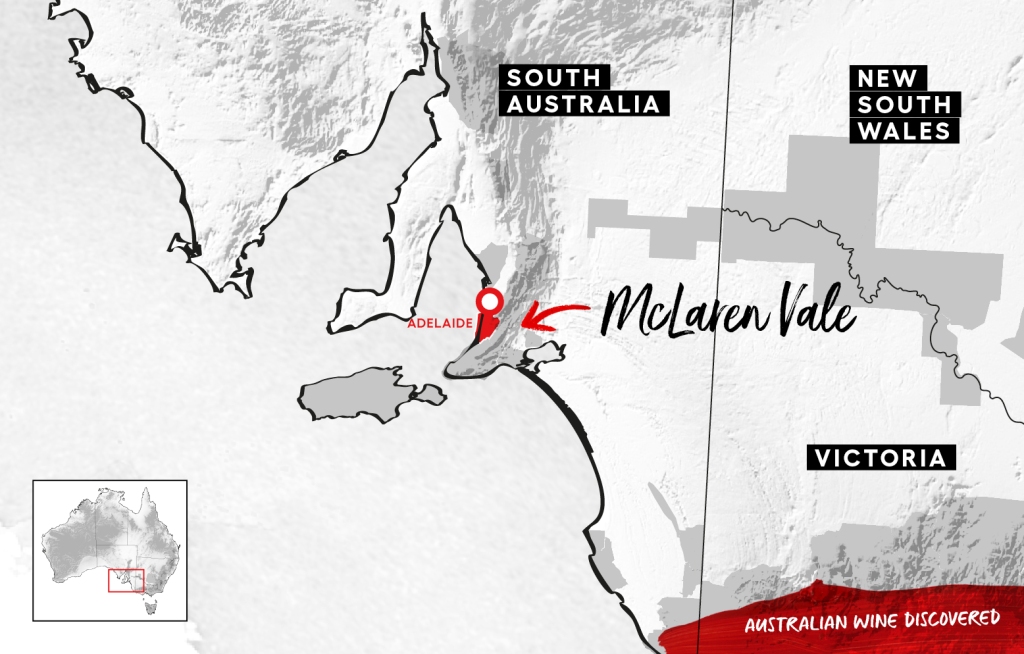
Today we ventured into McLaren Vale. In terms of climate this is between Adelaide Hills (cooler) and Barossa Valley (warmer). This was one of the first wine regions in Australia to be planted. The percentage of surface area planted with vines is the highest in Austria at 17%.
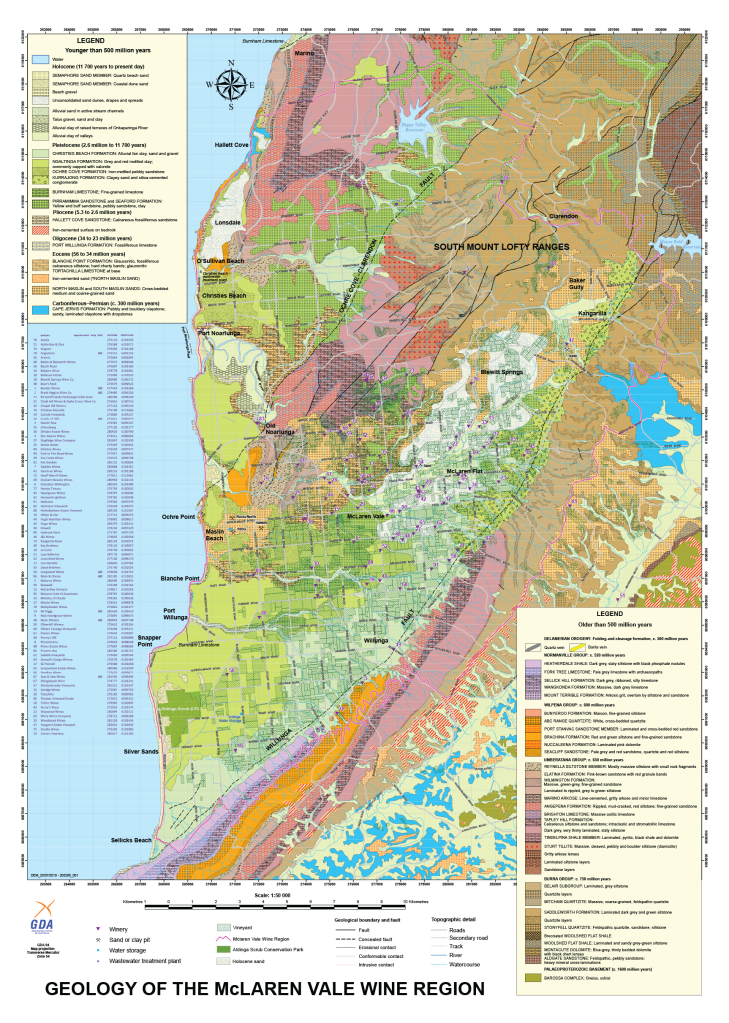
McLaren Vale has a large variety in soil types and wine styles.
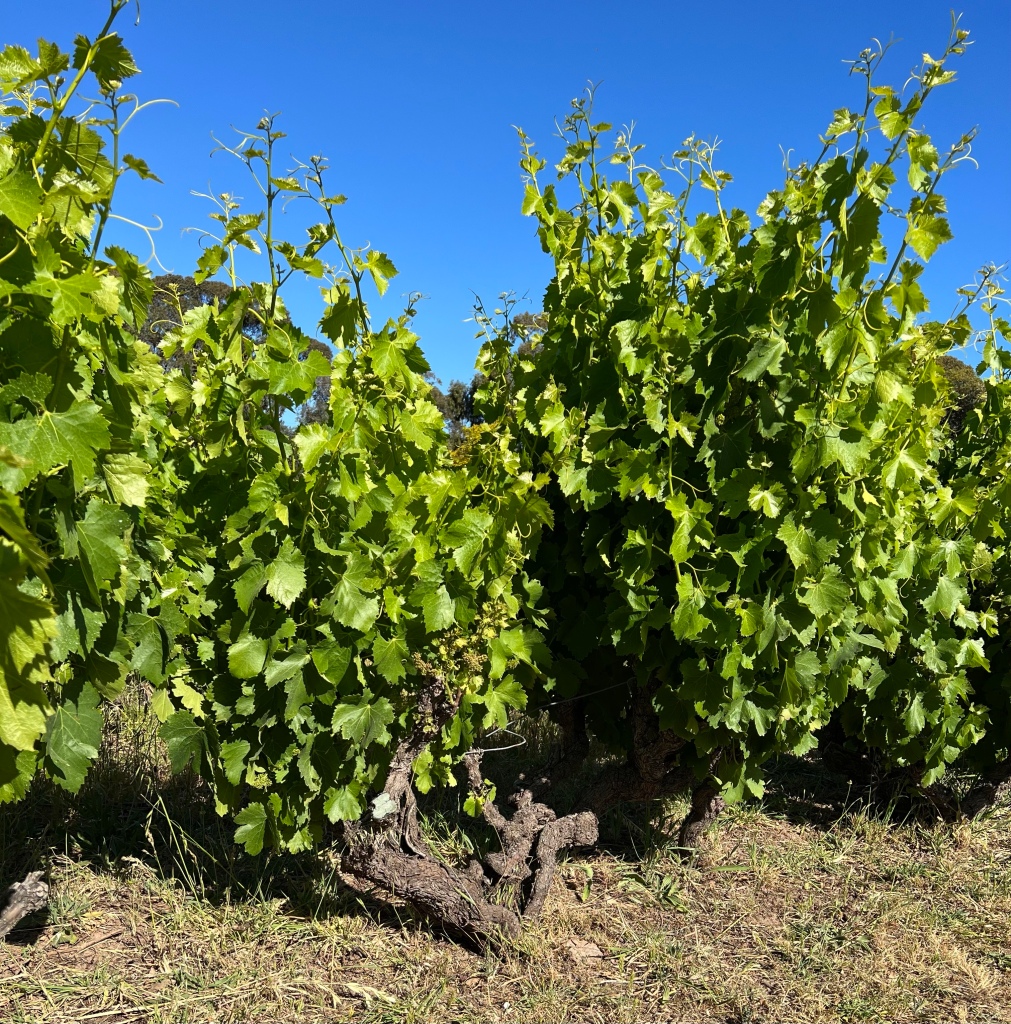
The speciality is old vine Grenache. They are ‘free standing’ bush vines.
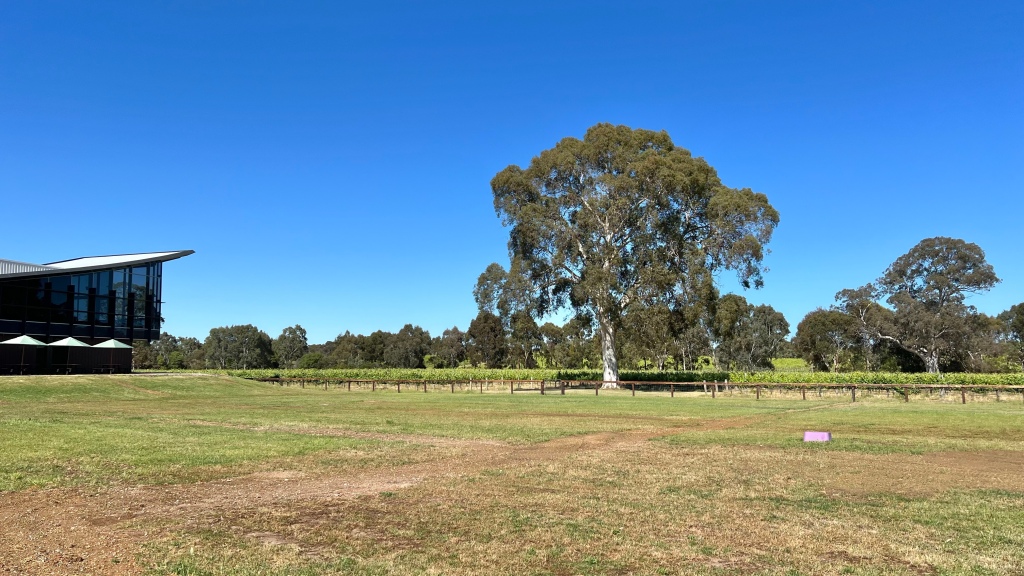
The fist winery we visited was Yangarra. They produce all their wines from fruit grown at the property and use biodynamic viticulture.
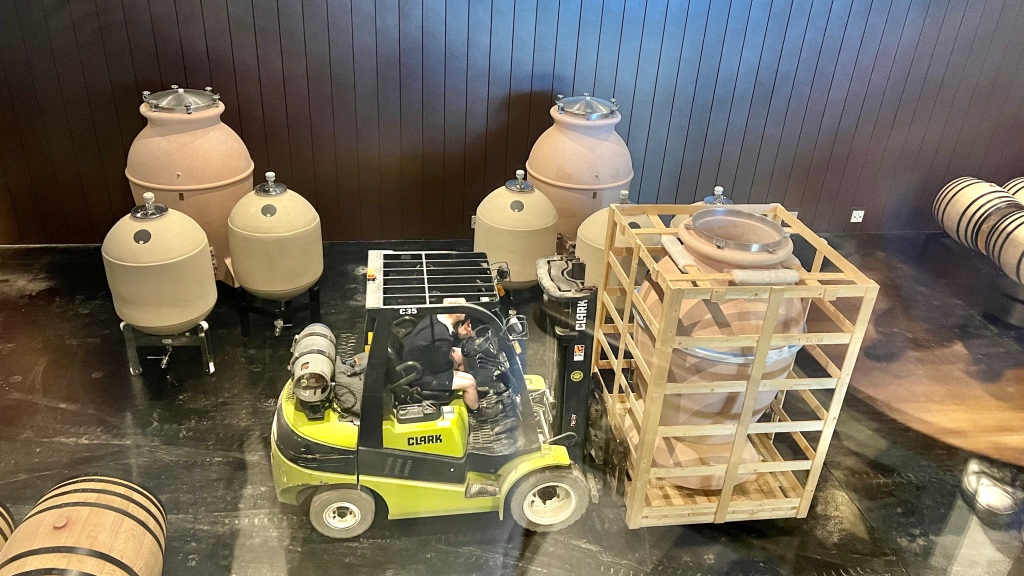
Yangarra specializes in varieties from the Soutern Rhône and ages most of the wines in ceramic eggs. The winemaker is French.
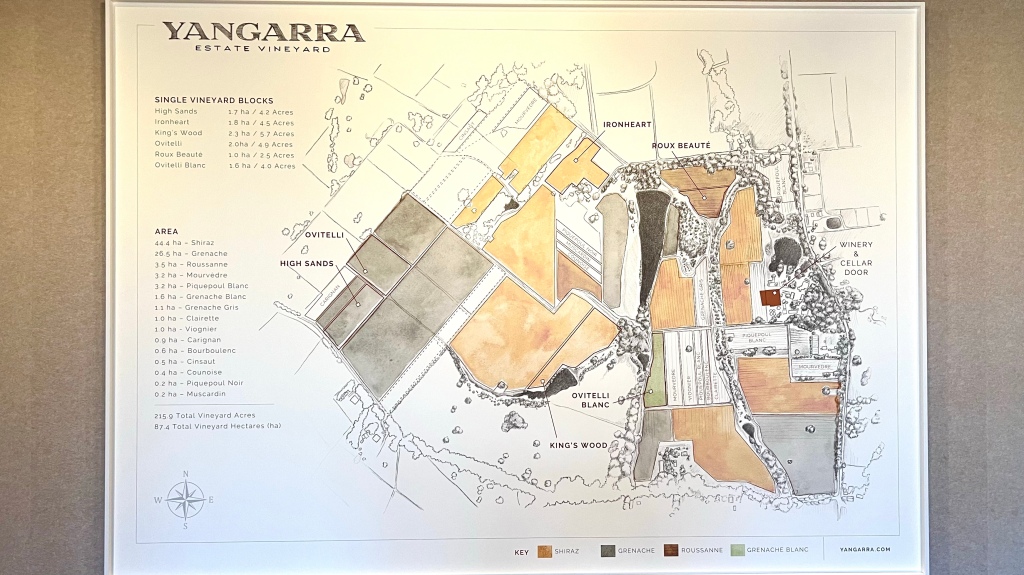
The vineyards are in the cooler part of McLaren Vale, about 2 degrees Celcius (4 degrees Fahrenheit) cooler than other parts, mostly sandy soils.
We tasted these wines:
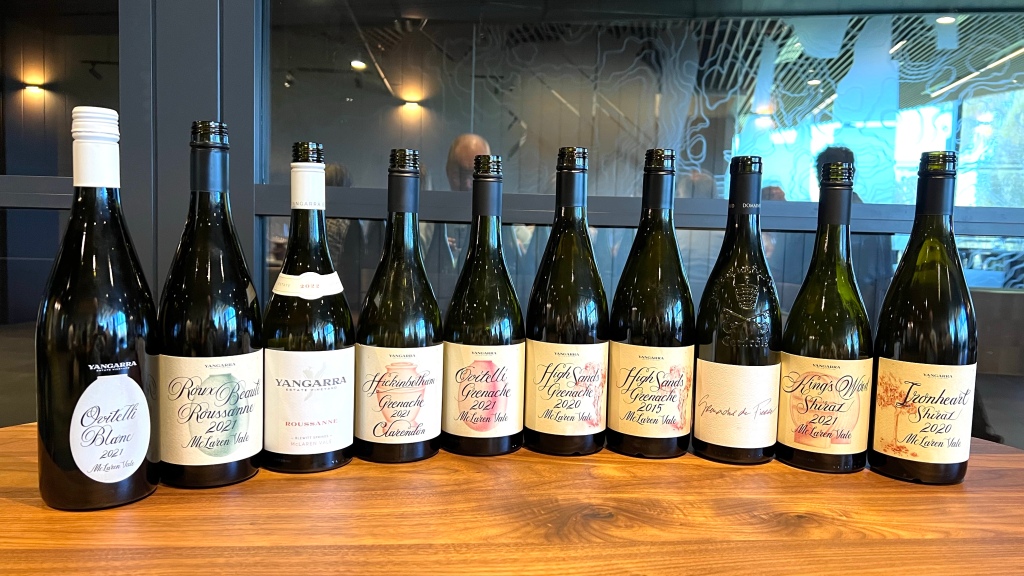
- Ovitelli Blanc 2021 (73% Grenache Blanc, 27% Roussanne, aged in ceramic eggs for 5 months, of which 40% on the skins): very light color, restrained aroma, creamy, elegant.
- Roux Beauté Roussanne 2021 (100% Roussanne, 45% aged on the skins in ceramic eggs and part in terracotta egg): earthy, structured.
- Roussanne Blewitt Springs 2022 (100% Roussanne from younger vines, aged 6 months in 500 litre pungeons of French oak, 20-25% new): oak, fruity aromas, complexity through structure.
- Ovitelli Grenache 2023 sample (aged 6 months in ceramic eggs on the skins, pressed 2 weeks ago, will be aged for 6 more months in ceramic eggs before being bottled): elegant and fresh, tannins still astringent.
- Ovitelli Grenache 2021: caramel, red fruit, texture, elegant, fresh, tannins still grainy, needs more time in the bottle
- Hickinbothan Clarendon Grenache 2021 (vines planted in 1971): red fruit, firm ripe tannins
- High Sands Grenache 2020 (vines planted in 1946 with a low yield of only 15-20 hl/ha, deep sand bush vines, open ferment and then transferred to a tank for further maceration and malolactic fermentation, then pressed and aged in ceramic eggs, large oak foudres, and 500 litre pungeons): oak, warm, firm ripe tannins.
- King’s Wood Shiraz 2021 (98% Shiraz, 2% Viognier, 25% whole bunch, aged in oak pungeons of which 25% new): eucalyptus, firm ripe tannins.
- Ironheart Shiraz 2020 (100% Shiraz, 25% whole bunch, aged in oak pungeons of which 25% new): earthy, coffee, firm ripe tannins.
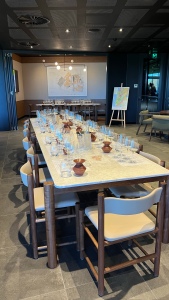
One member of our group had brought a bottle of a 2015 100% Grenache from Châteauneuf-du-Pape to be compared with the High Sands Grenache by Yangarra of the same vintage. The Yangarra was more fresh than its French counterpart, but the tannins needed more time to become soft. The tannins in the Domaine Giraud Châteauneuf-du-Pape Grenache de Pierre 2015 (100 year-old vines) were velvety, but the aroma was more developed.
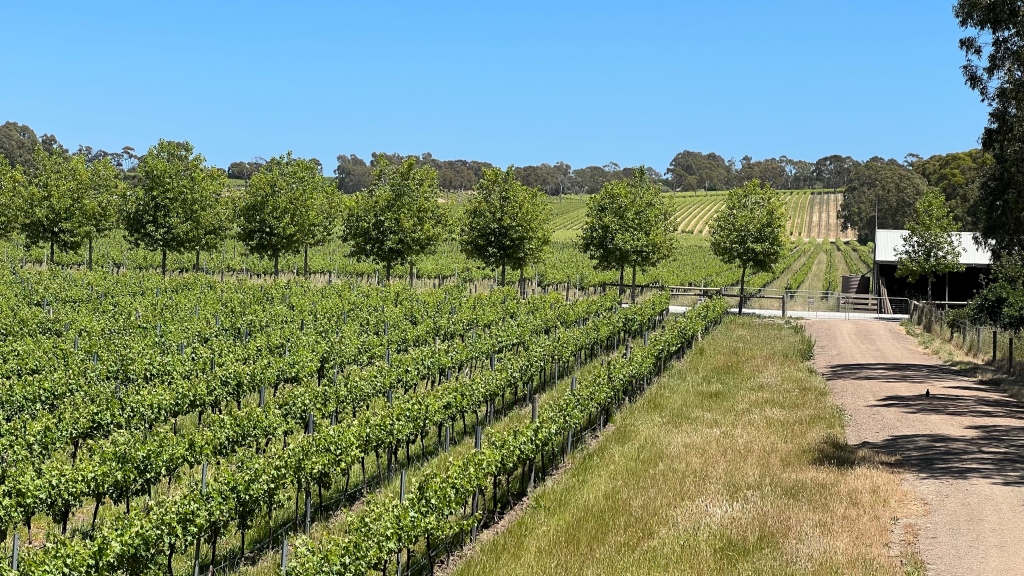
The second winery in McLaren Vale we visited was Wirra Wirra. The name means “among the trees” in the language of the indigenous people of the area. The winery was originally founded in 1894 by Robert Strangways Wigley, a noted South Australian eccentric and state cricketer, and rebooted in the 1960s. From 2010 they have moved to biodynamic farming. McLaren Vale has 40% organic vineyards compared to the Australian average of only 5%. The dry climate and cool breezes from the ocean help to keep the disease pressure low. Wirra Wirra has sheep grazing in the vineyards as a natural way to keep the weeds in check (you can see in the photo that the neighbor removes all the weeds; which means that he lacks the natural cooling that the weeds will provide).
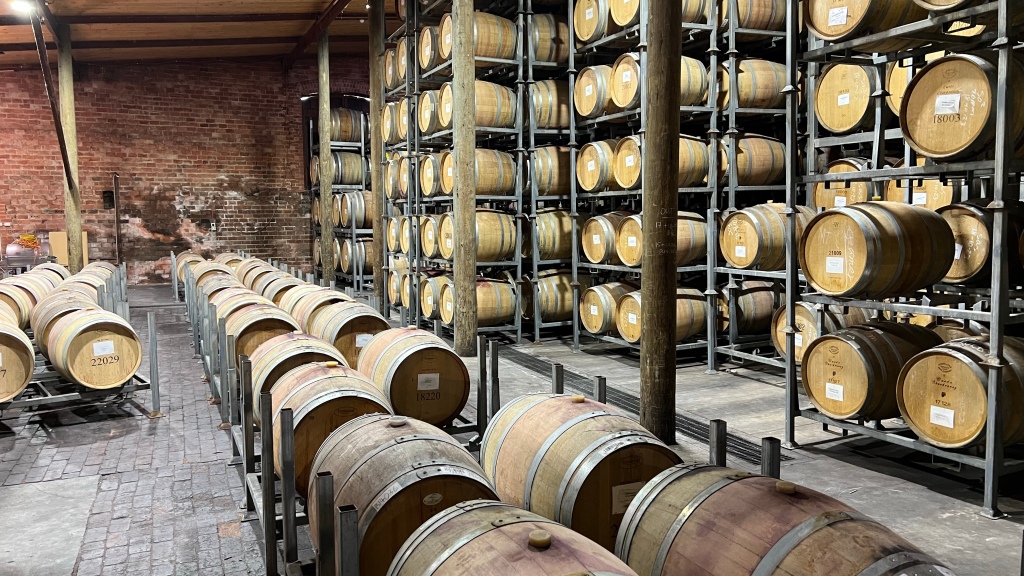
Although there is no phylloxera in South Australia, vines are grafted on different rootstock anyway to restrict the water usage and for vigour control. Wirra Wirra produces 1.8 million bottles per year, 20% of their own fruit from 20 hectares of Vineyards in McLaren Vale and 20 hectares in Adelaide Hills, and the remaining 80% from fruit from other farmers. The wine makers were excited to tell us about the new equipment that was being installed, which is a vibrating sorting table that will help to get just the clean grapes (‘caviar’) to make wine from.
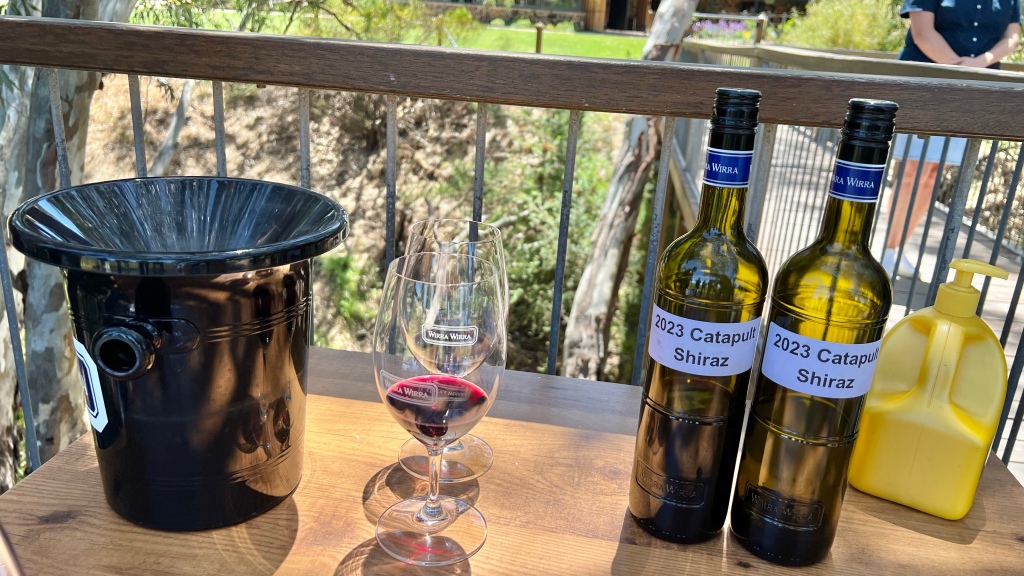
We started with a barrel sample of the 2023 Catapult (100% Shiraz) while overlooking the vineyard. This was fresh and medium bodied with fruity aromas and ripe tannins.
With lunch we had the following wines:
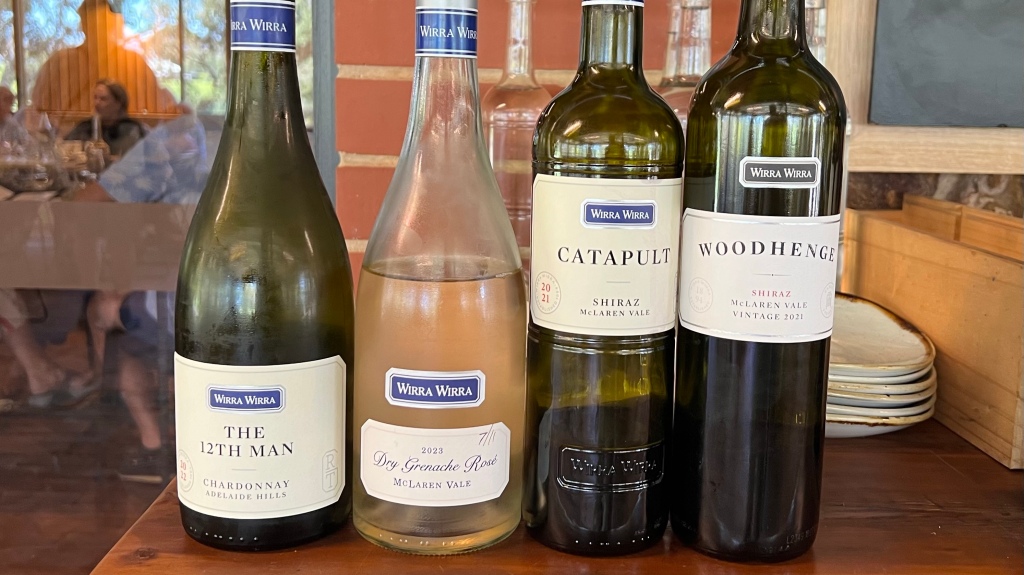
- The 12th Man 2022 (100% Chardonnay, 8 months in French oak pungeons): oak, citrus, balanced acidity.
- Grenache Dry Rosé 2023: red fruit, not completely dry.
- Catapult 2021 (Shiraz): soft tannins, ripe fruit.
- Woodhenge 2021 (Shiraz, more new oak than Catapult): perfumed, soft ripe tannins. Complex.
The lunch consisted of:
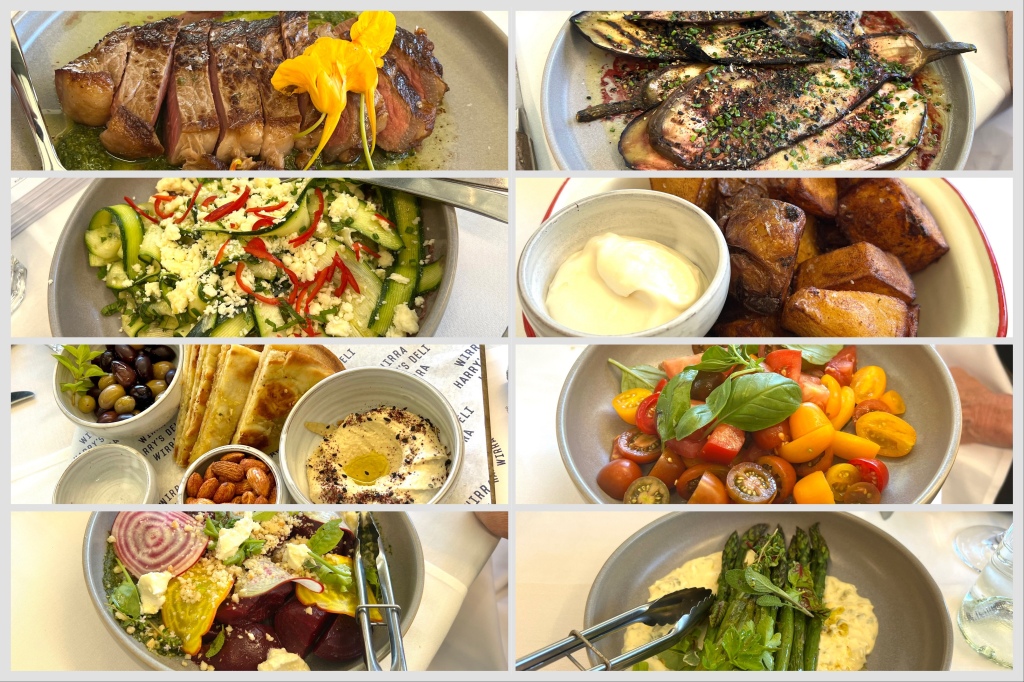
- Grilled asparagus with Sauce Gribiche
- Roasted and Raw Beetroot with goat’s cheese and macademia
- Roasted eggplant with Tahini dressing, Zatar, and pomegranate
- Black Angus Sirloin steak with salsa verde
- Zucchini salad with feta and mint
- Heirloom tomato salad
- Roasted potatoes with aioli
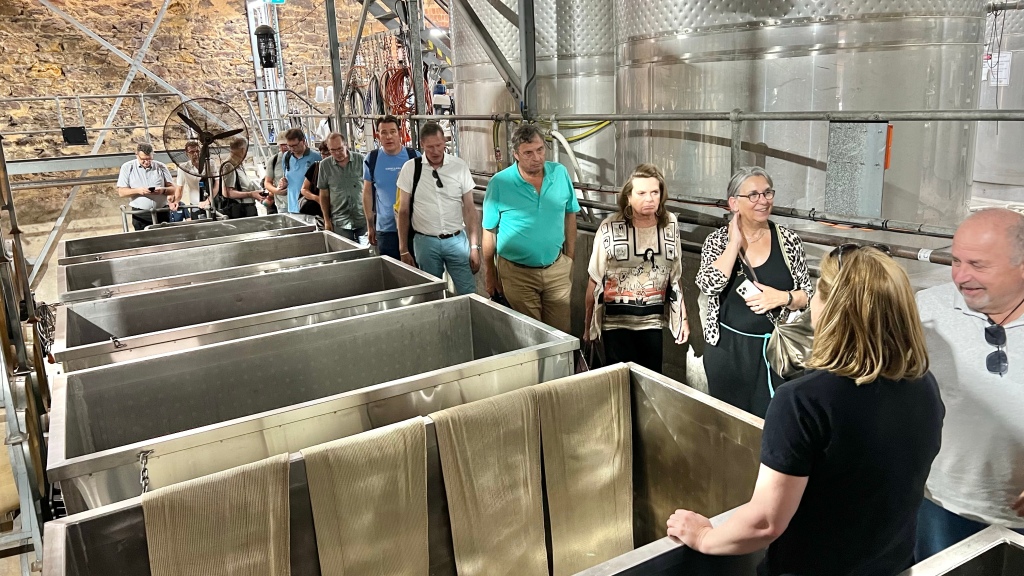
Then we had a tour of the cellar.
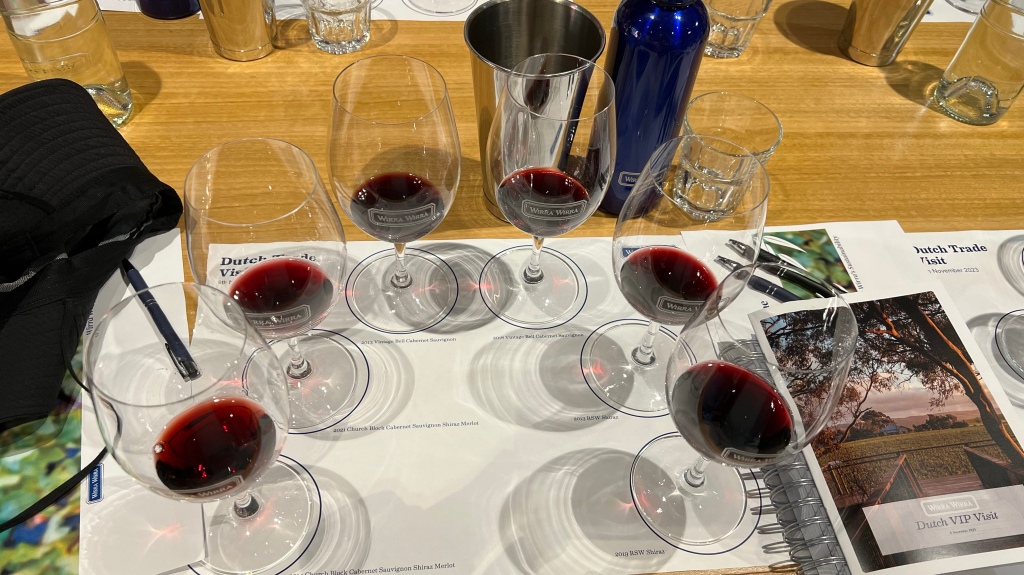
This was followed by a vertical tasting of the flagship wines of Wirra Wirra (2 vintages of each wine):
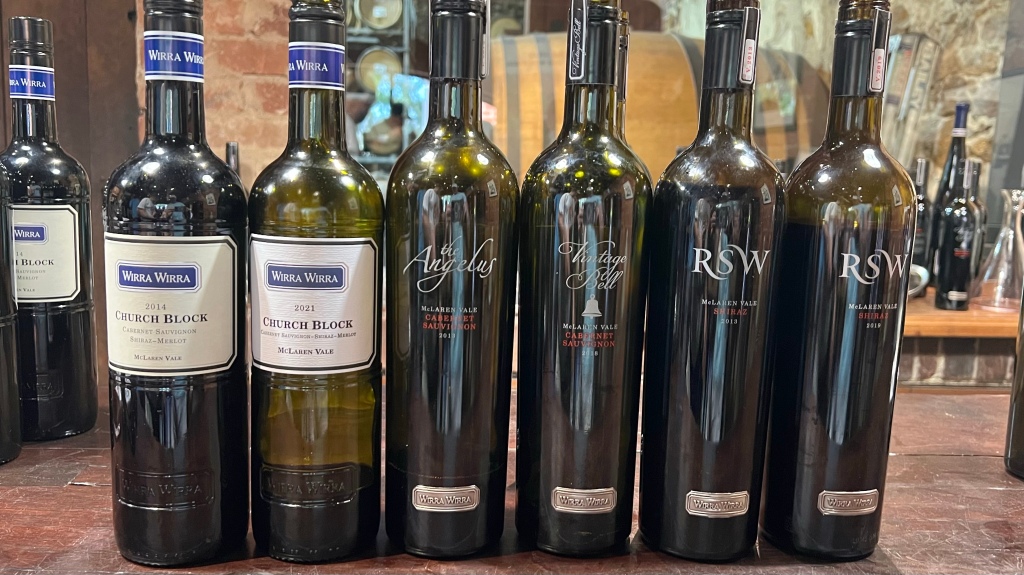
- Church Block 2021 & 2014 (50% Cabernet Sauvignon, 45% Shiraz, 5% Merlot): for AU$25 this is a ‘serious’ wine that can age very well. Both the 2021 and the 2014 are fresh and have firm but ripe tannins. The 2021 has some herbaceous notes and the tannins in the 2014 have softened.
- Vintage Bell 2018 & 2013 (100% Cabernet Sauvignon, the best Cabernet fruit of the vintage is used for this wine, it is aged for 18 months in French oak, of which 20-25% new, and then aged for a further 2 years in the bottle; in Australia it is called Angelus but name is not allowed for export as it is the name of a French château from Bordeaux): firm tannins with well integrated oak (already in the 2018 vintage), both are fresh and the 2013 is still very vital.
- RSW 2019 & 2013 (100% Shiraz, named after Robert Strangways Wigley, a noted South Australian eccentric and state cricketer who established Wirra Wirra in 1894, aged for 18 months in French oak, of which 20-25% new, and then aged for a further 2 years in the bottle): both have firm but ripe tannins and are fresh and elegant; the 2019 has a restrained aroma whereas the bottle age has brought out the blackberry aromas in the 2013.
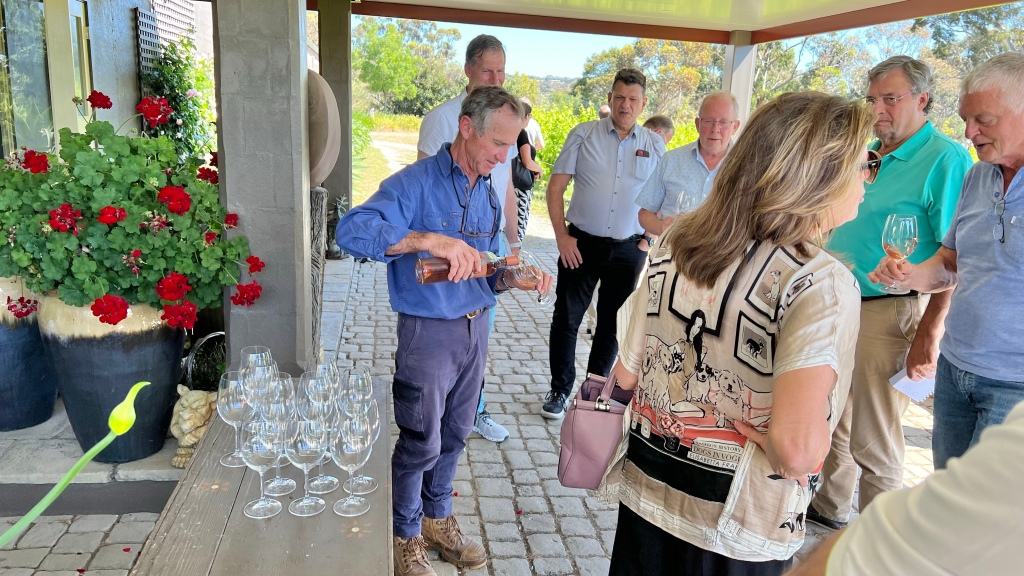
Our final tasting for today was at Noon Winery, a very small winery that produces only 30,000 bottles per year. Most of the production is sold through members of the wine club (with a waiting list to get in the club) and the remainder at the cellar door and some export. Drew Noon, the winemaker and owner of the winery, is a very nice guy who makes very nice wines. He has 6 hectares of his own vineyard with mostly Grenache and uses the fruit from a 3 hectare vineyard with Shiraz and Cabernet at Langhorne Creek, 50 minutes to the South. We tasted the following wines:

- High Noon Rosé (90% Grenache with 10% Mataro (Mourvèdre) to fill up the foudre): a full-bodied rosé with 14.9% alcohol but balanced anyway (if chilled).
- Noon Eclipse 2022 (81% Grenache, 14% Shiraz, 5% Graciano) & 2021 (90% Grenache, 6% Shiraz, 4% Graciano): lush but fresh with ‘sticky’ tannins; the 2021 is more fresh than the 2022 and has substantially lower alcohol (15.4% instead of 16.0%).
- Reserve Shiraz 2022 & 2013 (50% whole bunch, 30% new oak): the 2022 is ready to drink, full-bodied and lush with firm but ripe tannins. It is ready to drink, but the 2013 shows that it can also be cellared for 10 years. The 2013 has dark fruit, the tannins are still firm and despite around 16% alcohol both vintages are balanced and fresh.
- Reserve Cabernet 2022 & 2016: both have an aroma like a Bordeaux, with the 2016 slightly more herbaceous aroma and slightly lower alcohol. The tannins in the 2022 are still quite grainy and have softened in the 2016. Both are fresh.
- V.P. 2022 (Fortified Grenache, 18% alcohol, aged 18 months in used barrels): blackberry aroma (slightly developed), sweet, firm ripe tannins.
- At AU$ 30 per bottle these wines offer remarkable value for money, so I am not surprised there is a waiting list to become a member of the wine club.

We had Chinese for dinner at T-Chow:
- Prawn dumplings
- Vegetarian dumplings
- Prawn cabbage rolls
- Spring rolls
- Duck
- Green peppercorn chicken
- Steamed garlic scallops
- Salt & Pepper Lobster tails
- Soft shell crab
- Pork Spare Ribs with Tamarind Sauce
- Salt & Pepper Eggplant
- XO Fried rice

There was wine with this as well:
- Willunga 100 Grenache Rosé McLaren Vale
- Pewsey Vale The Countours Museum Reserve Riesling 2016 Eden Valley
- Dalrymple Pinot Noir 2022 Tasmania
- The Lane Sauvignon Blanc 2023 Adelaide Hills


What fun! And that food!!!
LikeLiked by 1 person
Interesting read for me as have never visited McLaren Vale but drunk many of the wines emanating from there. Am making notes 😉 ! Presuming you are still in SA am wishing you the best coping with 40C temps forecast for you today! Hope the AC does work everywhere !!! Am trying to ‘taste’ your meals . . . like the lunches . . . looking up Trip Advisor for another evening visit . . . hmmm !!!
LikeLiked by 1 person